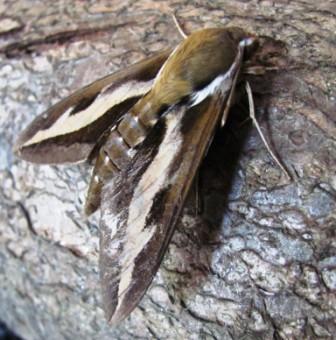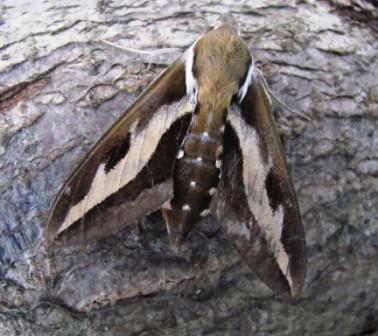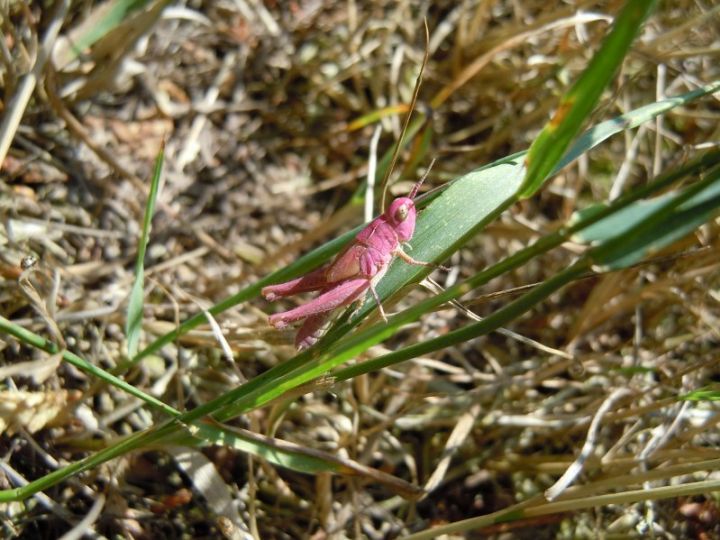Your Forum
The weblog below is for naturalists to use to report interesting sightings, ask questions, report on field meetings and generally post pictures and any information or questions generally relevant in some way to the wildlife and geology of Essex. You will need to register and be logged-on to post to the forum, and you need to upload pictures first, for use in posts. Find out more
|
Sun 22nd August 2010 17:29 by Graham Smith Bedstraw Hawk Moth at Ingatestone
August 19th : Moth trapping is like bird ringing; it might be scientific in its objectives but more basic forces come into play on each round of the nets or when you open up the moth trap in the morning. Realism is transcended by fantasy and dreams of finding a Himalayan Rubythroat hanging in the net or an Oleander Hawk Moth nestling on the egg boxes come to the fore, no matter that you might be ringing at Roding Valley Meadows or trapping in a suburban garden at Ingatestone! The Oleander Hawk Moth remains a dream but the Bedstraw Hawk Moth that turned up in my garden trap last Thursday runs it quite close, at least in my eyes, and is the first of the rarer migrant hawk moths to come my way in twenty years of trapping. In the 'Moths of Essex' (2004) Brian Goodey descripes it as a scarce immigrant, which is a euphemism for "you'll be lucky"! Well, on this occasion I was and I hope you enjoy the photographs.
Fri 13th August 2010 15:34 by Graham Smith Agrocybe rivulosa at Ingatestone
August 4th : Somebody has recently been fly tipping large piles of woodchips on roadside verges at Ingatestone; an anti-social act, of course, but one not without its benefits for an amateur mycologist! One such pile, at the entrance to a small wood known as The Grove (TL647007), soon began to sprout fungi; a species that initially - with its rather viscid, radially striate, amber coloured cap - suggested a Coprinus, and will continue to recall one to me long after they have all been transfered to another group, which probably won't be long delayed! 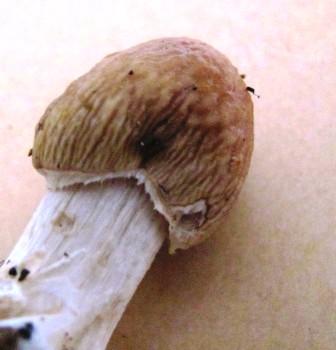 As the cap expanded it turned paler - to white, tinged with pale yellow brown - and in so doing exposed a large, loosely hanging ring high on the stem. It retained its markedly striate; or to be more exact, rugose (coarsely wrinkled) appearance though. As the cap expanded it turned paler - to white, tinged with pale yellow brown - and in so doing exposed a large, loosely hanging ring high on the stem. It retained its markedly striate; or to be more exact, rugose (coarsely wrinkled) appearance though. 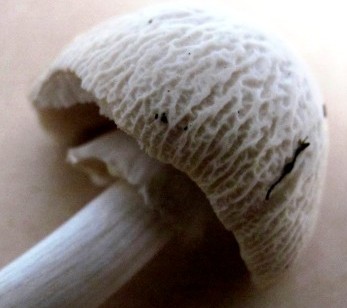 The gills were whitish when young, then pale grey, finally dark grey-brown; the few mature spores ellipsoid and 11-12um in length. Most of the mature specimens were old before their time due to the dry weather, hence the difficulty in finding mature spores. The stem was fibrillose (covered with thin fibres); white at first but browning from the base with age, and on some specimens markedly bulbous at the base, although not on the one illustrated, whose base was fused with its immediate neighbour. The pale to medium brown, thick-walled spores (among other things) identified it as an Agrocybe and from there it keyed out fairly straighforwardly as Agrocybe rivulosa in 'Funga Nordica' (2008); its habit of growing on large piles of woodchips, together with the strikingly rugose cap, leaving few other options. The gills were whitish when young, then pale grey, finally dark grey-brown; the few mature spores ellipsoid and 11-12um in length. Most of the mature specimens were old before their time due to the dry weather, hence the difficulty in finding mature spores. The stem was fibrillose (covered with thin fibres); white at first but browning from the base with age, and on some specimens markedly bulbous at the base, although not on the one illustrated, whose base was fused with its immediate neighbour. The pale to medium brown, thick-walled spores (among other things) identified it as an Agrocybe and from there it keyed out fairly straighforwardly as Agrocybe rivulosa in 'Funga Nordica' (2008); its habit of growing on large piles of woodchips, together with the strikingly rugose cap, leaving few other options.
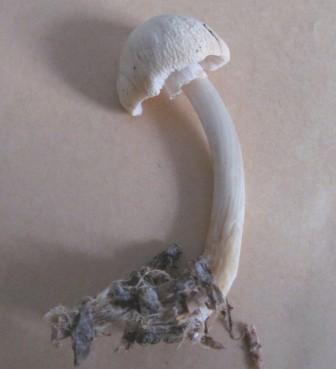 This was formerly a rare species in Britain; indeed, the BMI Checklist lists only one collection, from Derbyshire in 2004. Since then it has been turning up in increasing numbers, invariably on woodchips, and the latest on line BMI database contains around 140 records. None, however, relate to Essex, but enquiries by Tony Boniface, the County Recorder, revealed that Geoffrey Kibby had found it recently on woodchip piles behind the Epping Forest Field Centre. As it was until recently a rare find there are few illustrations in the more popular Field Guides but I eventually found a good photograph on the 'Wild About Britain' website. A full description was taken and the specimens retained. One to look out for!
This was formerly a rare species in Britain; indeed, the BMI Checklist lists only one collection, from Derbyshire in 2004. Since then it has been turning up in increasing numbers, invariably on woodchips, and the latest on line BMI database contains around 140 records. None, however, relate to Essex, but enquiries by Tony Boniface, the County Recorder, revealed that Geoffrey Kibby had found it recently on woodchip piles behind the Epping Forest Field Centre. As it was until recently a rare find there are few illustrations in the more popular Field Guides but I eventually found a good photograph on the 'Wild About Britain' website. A full description was taken and the specimens retained. One to look out for!Tue 10th August 2010 16:39 by Graham Smith The Mystery of the Reappearing Hare's Ears
Blue House Farm EWT Reserve : In 2008 a botanical survey of this reserve was carried out. One of the species on the hit list was the Slender Hare's Ear Bupleurum tenuissimum, a plant encountered there previously, usually growing in seepage areas on the flat grassy area between the seawall and adjoining borrowdyke. Despite repeated searches this spindly annual with tardily opening umbels of tiny white flowers failed to show. It is declining in Essex and this result seemed to suggest its demise at Blue House. This year further searches were made. June turned to July without any luck but on August 1st a small patch was found at the eastern end of the reserve, close to Bridgemarsh Creek. A return visit on 9th revealed not one patch but dozens, stretching for several hundred yards back towards North Fambridge. A 1m x 1m quadrat was marked out in a sample patch and the plants inside counted. This was then extrapolated over the entire area where they were growing and the result was a rough estimate of around 20,000 plants! Some demise!
What has changed between 2009 and 2010? The Environment Agency have been working on repairing the seawall in that area for the past two winters, often using heavy machinery to do so. The damage they caused to the grassland at the base of the seawall seemed to have little effect on the flora in 2009 but in March this year, with the end of the financial year looming and money to spend, they decided to give the seawall a spring cut. The ground was still wet from the winter rains and as a result their machinery goughed out huge ruts, especially in existing seepage areas, leaving large areas of bare mud exposed. Earlier this summer there had been a dramatic upsurge in the amount of Lesser Sea Spurrey Spergularia marina, Grass-leaved Orache Atriplex littoralis, Sea Rush Juncus gerardii, Borrer's Saltmarsh Grass Puccinellia fasciculata, and both Hard Grass Parapholis strigosa and Curved Hard Grass P. incurva growing in these areas but they proved to be just the forerunners for this spectacular display; or at least it was spectacular if you like thin, straggly, weedy looking umbellifers! A bonus, on this particular day, was a large group of Corn Parsley Petroselinum segetum growing among them, a new species for the reserve and one long looked out for. And the moral of this story : if you are a botanist never pass up the chance to examine disturbed ground, whether it be a roadside verge of chewed up seawall. Mon 9th August 2010 16:49 by Peter Harvey
It's not really my group, but from the sharply angled pronotal side keels and incompletely formed stubby wings, I would say this is probably a subadult male colour variety of the Field Grasshopper Chorthippus brunneus. This is a very variable species. Sun 8th August 2010 00:06 by Danny Harris Wed 4th August 2010 17:23 by Graham Smith Scarce Blue-tailed Damselfly at The Backwarden 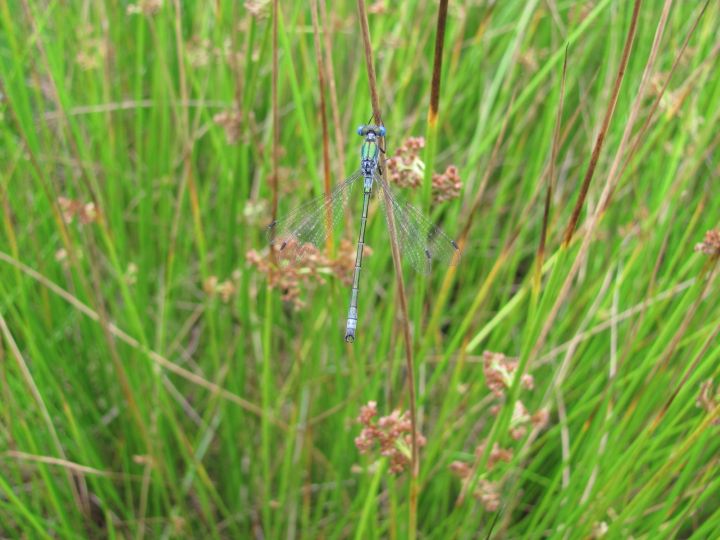 Several emerald damselflys were discovered flying among the thick vegetation surrounding the sphagnum pool at The Backwarden EWT Reserve, Danbury on July 11th. They seemed too robust for Common Emeralds, Lestes sponsa, and thanks to the wonders of digital photography (and its zoom facility) it proved possible to observe the critical distinguishing characteristics between this species and the Scarce Emerald Lestes dryas from even small photographs. To elaborate, the tips of the males inferior anal appendages are bent towards each other at the tip Several emerald damselflys were discovered flying among the thick vegetation surrounding the sphagnum pool at The Backwarden EWT Reserve, Danbury on July 11th. They seemed too robust for Common Emeralds, Lestes sponsa, and thanks to the wonders of digital photography (and its zoom facility) it proved possible to observe the critical distinguishing characteristics between this species and the Scarce Emerald Lestes dryas from even small photographs. To elaborate, the tips of the males inferior anal appendages are bent towards each other at the tip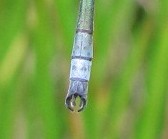 and the prunosity on segment two of the abdomen is restricted to the top two thirds and the prunosity on segment two of the abdomen is restricted to the top two thirds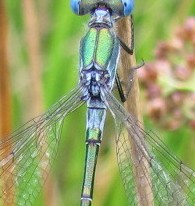 . Both these features can be seen (I hope) on the photographs. The Sphagnum Pool meets this species ecological requirements exactly, especially following recent conservation work to remove some of the reedmace surrounding it. It regularly floods in winter and dries out in summer, the mud (resulting from the reedmace removal) being colonised by a thick cover of emerging vegetation such as Juncus rushes, spike-rush and Lesser Spearwort. Later in July several pairs were observed mating and, on August 2nd, females egg laying. In total, around fifteen individuals were seen.
This species has always been associated with coastal borrowdykes in Essex, especially those containing beds of Sea Club Rush. The map in Ted Benton's and John Dobson's 'Dragonflies of Essex' (2007) show only two inland locations (in TQ59 and TQ69), the rest being confined to tidal river systems. The current British Dragonfly Society website maintains the impression that this species is strictly coastal but the population dynamics of dragonflies in this country is changing year or year and I have heard rumours of a number of other inland sites in Essex. Still, it is encouraging that this species has colonised The Backwarden following conservation work, even if that work was intended to benefit the Great Crested Newts! . Both these features can be seen (I hope) on the photographs. The Sphagnum Pool meets this species ecological requirements exactly, especially following recent conservation work to remove some of the reedmace surrounding it. It regularly floods in winter and dries out in summer, the mud (resulting from the reedmace removal) being colonised by a thick cover of emerging vegetation such as Juncus rushes, spike-rush and Lesser Spearwort. Later in July several pairs were observed mating and, on August 2nd, females egg laying. In total, around fifteen individuals were seen.
This species has always been associated with coastal borrowdykes in Essex, especially those containing beds of Sea Club Rush. The map in Ted Benton's and John Dobson's 'Dragonflies of Essex' (2007) show only two inland locations (in TQ59 and TQ69), the rest being confined to tidal river systems. The current British Dragonfly Society website maintains the impression that this species is strictly coastal but the population dynamics of dragonflies in this country is changing year or year and I have heard rumours of a number of other inland sites in Essex. Still, it is encouraging that this species has colonised The Backwarden following conservation work, even if that work was intended to benefit the Great Crested Newts! |
Archives: May 2020Aug 2019 Jan 2019 Sep 2018 Jul 2016 Oct 2015 Jul 2015 May 2015 Apr 2015 Mar 2015 Feb 2015 Jan 2015 Dec 2014 Oct 2014 Sep 2014 Aug 2014 Jul 2014 May 2014 Apr 2014 Mar 2014 Feb 2014 Jan 2014 Dec 2013 Nov 2013 Sep 2013 Aug 2013 Jul 2013 Jun 2013 May 2013 Apr 2013 Mar 2013 Feb 2013 Jan 2013 Dec 2012 Nov 2012 Oct 2012 Sep 2012 Aug 2012 Jul 2012 Jun 2012 May 2012 Apr 2012 Mar 2012 Feb 2012 Jan 2012 Dec 2011 Nov 2011 Oct 2011 Sep 2011 Aug 2011 Jul 2011 Jun 2011 May 2011 Apr 2011 Mar 2011 Feb 2011 Jan 2011 Dec 2010 Nov 2010 Oct 2010 Sep 2010 Aug 2010 Jul 2010 Jun 2010 May 2010 Apr 2010 Mar 2010 Feb 2010 Nov 2009 Oct 2009 Aug 2009 Jul 2009 Jun 2009 May 2009 Apr 2009 Mar 2009 Feb 2009 Jan 2009 Nov 2008 Oct 2008 Sep 2008 Aug 2008 Jul 2008 Jun 2008 May 2008 Apr 2008 Mar 2008 Feb 2008 Jan 2008 Dec 2007 Nov 2007 current posts |



















